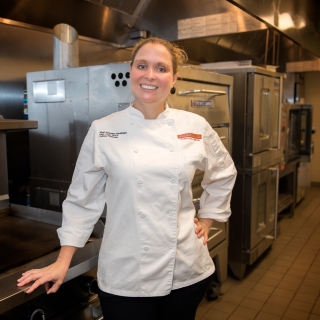
Deciphering Learning Styles and Unlocking Education: Part Two
31 January 2024Planning effective lessons based on learning styles from learning environments to classroom and homework activities.
By Dr. Jennifer Denlinger, CCC, CHEP
Feedback & comments: This email address is being protected from spambots. You need JavaScript enabled to view it.
OK, now what? In the first installment of Deciphering Learning Styles, you read about the sensory learning modalities of VARK, Visual, Aural, Read/write and Kinesthetic. You now know your students may have different ways of learning best. I provided you with a VARK assessment for culinary students to help determine their specific styles. Did you find it interesting? I like to compare the results of my pastry program students to my culinary program students. Wow! There is a such difference in learning styles between the two groups!
I assume you took the assessment and have a good understanding of your learning style too. Did the results surprise you or did you already know? This is important to teaching effectively, understanding how you receive and learn information may be very different than the majority of your students.
 Focusing on how students learn (and not necessarily how you learn) concerns all educators. If lessons can be broken down into components, and then each component is taught in a way that is most beneficial to the audience/students, then the delivered materials may be more successfully absorbed by learners. A simple awareness of differences in student learning styles is vital for educators to aid in the learning process. Effective instruction reaches out to all students, not just those with one particular learning style.
Focusing on how students learn (and not necessarily how you learn) concerns all educators. If lessons can be broken down into components, and then each component is taught in a way that is most beneficial to the audience/students, then the delivered materials may be more successfully absorbed by learners. A simple awareness of differences in student learning styles is vital for educators to aid in the learning process. Effective instruction reaches out to all students, not just those with one particular learning style.
Now that you know about the learning process, let’s look at how this information can be utilized in lesson planning. The information for this article comes from my dissertation, “The Effects of Brain Dominance on Pastry and Culinary Students’ Learning Styles.” My work focused on identifying different learning styles and how to use that information to teach more effectively.
(All references are at the end.)
Teaching tactics based on learning styles
Looking at similar studies in other fields, culinary instructors can see how this research could be useful in our education area. Medical students, when taught in their preferred learning style, learned and performed better than those taught with just the traditional lecturing method.i “While it might not be practically tenable to undertake the teaching of the entire syllabus by dividing a class into learning style-based groups, it is suggested that multiple audio, video, and kinesthetic resources be made available to students. They may then be encouraged to use learning style-specific resources for learning to enhance their academic performance and improve their understanding of subjects,” according to the Anbarasi study.
Table 1 – Learning preferences based on VARK® characteristicii
Check out the next two tables. The first one details how each learning style likes their information presented and how they record the information. It also details the least-liked way to receive information. The second table explains how each learning style has a very different environment where they like to learn.
| Likes | Uses | Avoid | |
| Visual |
|
|
|
| Likes | Uses | Avoid | |
| Auditory |
|
|
|
| Likes | Uses | Avoid | |
| Kinesthetic |
|
|
|
| Likes | Uses | Avoid | |
| Reading/Writing |
|
|
|
Table 2 – Learning habits and environments based on the learning characteristicsiii,iv,v
| Visual | Kinesthetic | Auditory | |
| Learning |
|
|
|
| Environment |
|
|
|
Now, think about your teaching tactics. Are you covering several learning styles when you present your lessons? Or are you presenting with one learning style in mind, for example lecturing with a PowerPoint deck that supports the Reading/Writing learning style but is not as effective for the Visual learner?
The next table provides classroom activities that cater to each learning style. How many of these options do you include during a course’s duration?
Table 3 – Preferred activities based on learning characteristics
| Visual | Analyze; critique; mathematical functions; scientific meanings; show the components; come up with a solution; exact measurements; gather facts; efficiency; give just the facts; individual tasks; collecting data; listening to informational lectures; reading textbooks; judging ideas based on facts; criteria and logical reasoning; summarize; identity specific outcom |
| Kinesthetic | Games; show an overview of desired goal; artistic; creative/designing; experimental; mystery basket; visual presentations; coming up with new concepts; variety of options and solutions; selling ideas; looking at the big picture; taking initiative; simulations (what if questions); visual aids; appreciate beauty of a problem; brainstorminges |
| Auditory | Physical activities; roleplay; social interactions; group work; reading assignments; demonstrations; participatory work where mistakes aren’t penalized; communication activities; teaching/training others; listening to and sharing ideas; looking for personal meaning; sensory input; group study; studying with music; discussion |
| Read/Write | Note taking in 90 min maximum segments; research; sequential information; set pattern or routine; exact replication; organize; action-oriented tasks; consistency; order and control; explanation; building things; paperwork tasks; following directions; repetitive detailed homework problems; making timetables; categorization |
How do culinary students usually classify?
In my culinary education research, the data for Learning Styles showed most respondents were visual learners. (The Read/Write category was not employed for this study. It was VAK, not VARK). For males, the most frequently observed category of Learning Style was Visual 2 (n = 32, 30%). For females, the most frequently observed category of Learning Style was Kinesthetic (n = 21, 24%). There are two visual categories (V1 and V2) as this is how the Learning style correlates to the brain region. I have folded these two categories together. As you can see, Auditory and Kinesthetic are both pretty low.
| Table: Learning Styles | ||
| Learning Style | N | Percent |
| Visual 1 | 52 | 27.66 |
| Visual 2 | 59 | 31.38 |
| Kinesthetic | 37 | 19.68 |
| Auditory | 40 | 21.28 |
| Total | 188 | 100 |
Note. Due to rounding errors, column-wise percentages may not equal 100%.
| Frequency Table for Nominal Variables by Gender | ||
| Learning Style | Male | Female |
| Visual 1 | 31 (29%) | 13 (15%) |
| Visual 2 | 32 (30%) | 11 (13%) |
| Auditory | 13 (12%) | 19 (22%) |
| Kinesthetic | 6 (6%) | 21 (24%) |
Note. Due to rounding errors, column-wise percentages may not equal 100%.
Conclusion
If you haven’t already, have your students take the learning style quiz (attached below) and make an assignment where they create a study plan based on their quiz results. As an instructor, you will then know how to change your teaching’s visual presence with the right among of demos, more colors, more patterns, and more categories.
I hope this helps you and your students.
Attachments
PowerPoint
Learning Style Self-Assessment
References
i Anbarasi, et. Al, 2015).
ii Fleming, N. (2012). Teaching and learning styles: VARK strategies. Retrieved from http://varklearn.com/wp-content/uploads/2014/08/VARK-Teaching-and-Learning-Styles.pdf
iii Fleming, N. (2012). Teaching and learning styles: VARK strategies. Retrieved from http://varklearn.com/wp-content/uploads/2014/08/VARK-Teaching-and-Learning-Styles.pdf
iv Morris, R. J. (2006). Left Brain, Right Brain, Whole Brain? An examination into the theory of brain lateralization, learning styles and the implications for education. PGCE Thesis, Cornwall College St Austell. Retrieved from http://singsurf.org/brain/rightbrain.html
v Whole Brain Thinking. (2005). Whole Brain Thinking and the NBI. Retrieved from http://www.wholebrainthinking.com.au/pdf/WBTintro.pdf
Chef Jennifer M. Denlinger, PhD., CCC, CHEP, is the Culinary Management Program Department Chair at the Poinciana Campus of Valencia College. She is also the vice president of ACF’s Central Florida Chapter. Additionally, Chef Denlinger earned the 2020 Innovation Award, sponsored by CAFÉ and the Idaho Potato Commission, for a creative escape room based on safe food handling procedures. She also earned the 2021 Green Award sponsored by the United Soybean Board and was runner-up in 2021 for the Postsecondary Education of the Year sponsored by Sysco Corporation.
